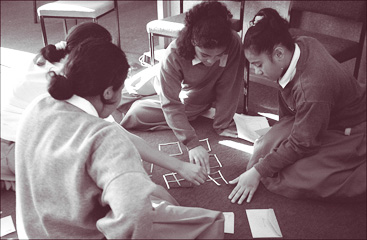New Zealand's National Education Monitoring Project commenced in 1993, with the task of assessing and reporting on the achievement of New Zealand primary school children in all areas of the school curriculum. Children are assessed at two class levels: Year 4 (halfway through primary education) and Year 8 (at the end of primary education). Different curriculum areas and skills are assessed each year, over a four year cycle. The main goal of national monitoring is to provide detailed information about what children can do so that patterns of performance can be recognised, successes celebrated, and desirable changes to educational practices and resources identified and implemented.
 Each
year, small random samples of children are selected nationally, then assessed
in their own schools by teachers specially seconded and trained for this work.
Task instructions are given orally by teachers, through video presentations,
or in writing. Many of the assessment tasks involve the children in the use
of equipment and supplies. Their responses are presented orally, by demonstration,
in writing, or through submission of other physical products. Many of the
responses are recorded on videotape for subsequent analysis.
Each
year, small random samples of children are selected nationally, then assessed
in their own schools by teachers specially seconded and trained for this work.
Task instructions are given orally by teachers, through video presentations,
or in writing. Many of the assessment tasks involve the children in the use
of equipment and supplies. Their responses are presented orally, by demonstration,
in writing, or through submission of other physical products. Many of the
responses are recorded on videotape for subsequent analysis.
In 1997, the third year that national monitoring was implemented, three areas were assessed: mathematics, social studies, and information skills. This report presents details and results of the assessments of information skills.
The framework for information skills identified three main content areas: clarifying information needs, finding and gathering information, and analysing and using information. Within each of these areas, various strategies, skills and processes were identified. The importance of attitudes and motivation was also noted.
Information about students' skills in clarifying information needs is presented in Chapter 3. About half of the year 4 students showed little development of these skills, while even year 8 students struggled with some of the tasks. Year 8 students were substantially more successful than year 4 students on the tasks which both year levels attempted. Selecting or developing good information-gathering questions is clearly a demanding intellectual task.
Chapter 4 presents results for one cluster of skills relating to finding and gathering information. These tasks tested the students' skills in searching for and finding appropriate sources of information, with particular emphasis on the use of libraries and their cataloguing systems. Both year 4 and year 8 students achieved substantial success, with about 25 percent more year 8 students than year 4 students succeeding on aspects common to both year levels. The largest differences occurred on a task involving the use of a computerised library catalogue, and on tasks which tested skills in organising library materials alphabetically or by classification number.
Tasks which asked students to find and use information from particular sources are included in chapters 5 and 6. Chapter 5 focuses on information from books, with Chapter 6 addressing other sources of information such as CD-ROM encyclopaedias, videos and posters. On average, about 25 percent more year 8 students than year 4 students achieved success on task components common to both year levels. Not surprisingly, students had less success where task components required some ingenuity, flexibility or persistence to find appropriate search keywords or routes. Perhaps more importantly, they also performed distinctly less well when asked to interpret or summarise information than when asked just to locate the information. Such tasks placed strong emphasis on the third content area of information skills (analysing and using information), as well as on the second (finding and gathering information).
Chapter 7 presents results for two tasks which were attempted by teams of four students. These tasks were clearly in the third content area, requiring students to sort and classify information. Year 4 and year 8 students were given similar but different tasks, and thus their achievements are not directly comparable. At both levels, many teams of students had difficulty identifying and setting aside irrelevant information, and many had difficulty developing categories which fitted the information well.
Results from a survey are presented in Chapter 8. The survey sought information from students about their strategies for, involvement in, and enjoyment of information gathering activities. Notable findings were the high levels of experience with computerised library catalogues (especially for year 8 students), the strong suggestion that year 8 students were feeling somewhat jaded about information finding projects, and the greater emphasis students at year 8 level placed on libraries as useful sources of information. It is interesting to note that computers were the most commonly identified source of information at both year levels.
Chapter 9 reports the results of analyses which compared the performance of different demographic subgroups. Very few differences on the tasks were found for students from different sized schools or communities, or from full primary or intermediate schools. At both levels, girls performed better than boys on about one quarter of the tasks, non-Mäori students performed better than Mäori students on about half of the tasks, and students attending schools with low socio-economic decile ratings or high proportions of Mäori or Pacific Island students performed less well than students at other schools on many tasks. The most unexpected finding was that year 8 students from the South Island out-performed their northern counterparts on about one third of the tasks.
Acknowledgements
The Project directors acknowledge the vital support and contributions of many
people to this report, including: